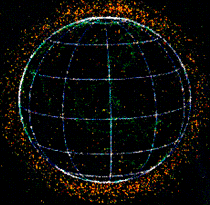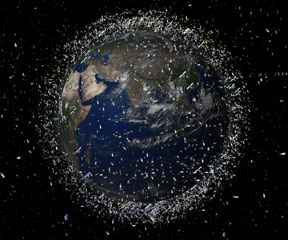Click on image for full size
NASA
Junk in Space!
News story originally written on June 30, 1997
Whether on Earth or in Space, human activity creates waste. Like the Earth's environment, the space environment is getting more and more cluttered. There are currently millions of man-made ruins that make up "space junk". Unfortunately, the past 30 years of space exploration have generated a lot of junk that poses a significant threat to spacecraft now in orbit. Orbital debris includes things such as hatches blown off space modules, paint fragments from the space shuttle, or satellites that are no longer in use.
Man-made debris orbits at a speed of roughly 17,500 miles/hour! Think of the damage even a small speck of paint could do if impact occurred at such high speeds!
Spacecraft must be designed to withstand hypervelocity impacts with these particles. Testing must be done on the shielding used for future spacecraft. Such experiments were actually undertaken in the Long Duration Exposure Facility (LDEF). The LDEF was deployed in orbit April 1984 by the Shuttle Challenger. It was retrieved 5.7 years later. During this time the LDEF was designed to take meteoroid and debris surveys involving many different materials.
Besides having appropriate shielding from space junk, a spacecraft can move out of the way to avoid impact with debris. Currently, the Aerospace Corporation in California is establishing a center that will do analysis of space debris avoidance. The Aerospace Center for Orbital and Reentry Debris Studies will provide improved warning of debris hazards, allowing mission planners to take evasive actions such as adjusting launch times and flight parameters.















